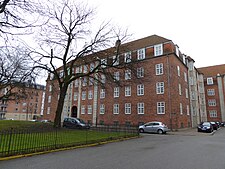Kanslergade Agreement
- Machine translation, like DeepL or Google Translate, is a useful starting point for translations, but translators must revise errors as necessary and confirm that the translation is accurate, rather than simply copy-pasting machine-translated text into the English Wikipedia.
- Do not translate text that appears unreliable or low-quality. If possible, verify the text with references provided in the foreign-language article.
- You must provide copyright attribution in the edit summary accompanying your translation by providing an interlanguage link to the source of your translation. A model attribution edit summary is
Content in this edit is translated from the existing Danish Wikipedia article at [[:da:Kanslergadeforliget]]; see its history for attribution. - You should also add the template
{{Translated|da|Kanslergadeforliget}}to the talk page. - For more guidance, see Wikipedia:Translation.

The Kanslergade Agreement (IPA: [ˈkʰænˀslɐˌkɛːðə]; Danish: Kanslergadeforliget) was a 1933 political agreement in Denmark, which laid the foundation for the Danish welfare state. It was enacted by the government of prime minister Thorvald Stauning, with social minister K.K. Steincke being its chief architect. The Kanslergade Agreement was negotiated in Stauning's apartment on Kanslergade in Copenhagen, from which it takes its name.
The agreement was reached by Stauning's government, consisting of his own Social Democratic Party and their coalition partner the Social Liberal Party, as well as the main opposition party the Liberal Party, on 30 January 1933. The two governing parties held a narrow majority of 76 out of 149 seats in Folketinget (the lower house of Rigsdagen). However, they only had 34 out of 76 seats in Landstinget (the upper house of Rigsdagen), and thus needed the support of the Liberals, who held 27 seats in Landstinget.
The Kanslergade Agreement set in motion the reforms that would establish the Nordic model for state welfare services in Denmark. It expanded labor rights, devalued the krone, and extended state subsidies to farmers. Charges for social services were also fixed to affordable levels. As part of the agreement, the Liberal Party withdrew its objections to the social welfare model advocated by the government. The agreement was, at the time, the most extensive agreement yet in Danish politics, with the possible exception of the 1894 budget agreement.[1]
See also
- The most recent elections before the Kanslergade Agreement:
- 1932 Danish Folketing election
- 1932 Danish Landsting election
- History of Denmark#1901–1939
- Labor rights
- Stauning II Cabinet
- Stauning or Chaos
- Welfare state
References
- ^ Skou, Kaare R. (2005). Dansk politik A-Å (in Danish). Aschehoug, pp. 367-68. ISBN 87-11-11652-8.
- Rerup, Lorenz (2007-04-30). Political extremism & emergency agreements. Gyldendal Leksikon. Retrieved on 2007-12-03.
- v
- t
- e











